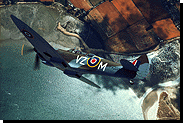
By the end of 1948 the tide had turned in the War of Independence and Israeli forces were pushing the invading Arab armies beyond the borders of mandatory Palestine. In a final bid to rout the Egyptian army, Israel launched operation "Horev", in which five Israeli brigades pushed into the Sinai desert in an attempt to encircle the retreating Egyptians. After five days of fighting, beginning on December 22nd 1948, Israeli victory was within sight. It was then however, that under an agreement with Egypt, Britain intervened and threatened Israel with retaliation should Israeli forces arrive in the Suez canal zone. Faced with such a warning Israeli plans changed and following the encirclement of the Egyptian forces in the Gaza strip, a ceasefire agreement was reached on January 6th 1949, due to go into effect on the afternoon of the 7th.
In order to further validate its warning, British presence in the air above the region was increased. At first a passive observer, the RAF based in Egypt started taking a more active role, intervening with IAF operations against the retreating Egyptian army.
On the morning of January 7th 1949, a few hours before the ceasefire was due to come into effect, four RAF 208th Squadron Spitfire F.22s took off from Faid to observe Israeli operations in the Sinai. Once over Israeli forces, however, the four aircraft came under attack from Israeli anti aircraft fire. The formation's no. 2, Frank Close, took a direct hit to his engine and was forced to bail his stricken aircraft. Soon, two Israeli Spitfires of the 101st "First Fighter" Squadron, were also on the scene. The Israeli pilots, Chalmers Goodlin and John McElroy, volunteers from the US and Canada, spotted the Spitfires and engaged them. McElroy scored his first kill against a Spitfire flown by Ron Sayers, while Goodlin went after the RAF flight leader, Geoff Cooper, and shot him down after a short dogfight.
McElroy, meanwhile, had spotted the fourth RAF Spitfire circling the wreckage of Close's aircraft. The last British Spitfire went down as well, its pilot, Tim McElhaw, bailing out before the aircraft hit the sand dunes of the Sinai. Ron Sayers was killed in the encounter, Close and McElhaw were captured by Israeli forces, while Cooper managed to evade capture and made it back to Egypt. The two captured pilots were released within a few days.

Although the IAF had gained overall air superiority in its encounters with the various Arab air forces, the prospect of facing the RAF was not one to be taken lightly and orders were issued to prevent a repeat of the combat with the British. These however, were soon ignored when four IAF Spitfires led by Ezer Weizman (former president of Israel) encoutered RAF Tempests looking for their four missing aircraft. In the ensueing dogfight, Bill Schroeder shot down an RAF Tempest, killing its pilot, David Tattersfield, while Weizman severely damaged another.
With the final result 5:0 in favor of Israel, a fierce British retaliation was expected. This failed to materialize however, apparently after the British government came under fire at home for intervening in Arab-Israeli affairs.
 back to the IDF/AF page
back to the IDF/AF page